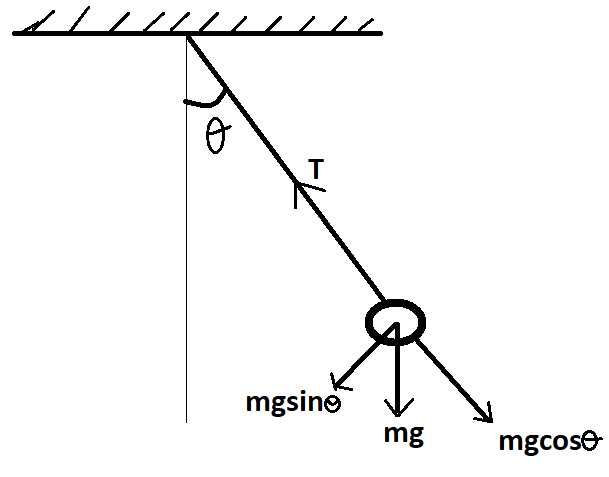
For a simple pendulum, relation between time period $T$, length of pendulum $l$ and acceleration due to gravity $g$is given by:
A. $T = 2\pi \dfrac{l}{{\sqrt g }}$
B. $T = 2\pi \sqrt {\dfrac{l}{g}} $
C. $T = 2\pi \dfrac{l}{g}$
Answer
470.7k+ views
Hint: The time period of the simple pendulum is defined as the time required to complete one complete cycle of oscillation.
Restoring force ${f_e}$ for the simple pendulum is:
${f_e} = - mg\sin \theta $
Here, $m$mass of the suspended particle, $g$acceleration due to gravity and $\theta $ is angular displacement from the me
a position.
For simple harmonic oscillation acceleration $a$ is given as,
$a = - {\omega ^2}x$
Here, $\omega $ is frequency of oscillation and x is the distance of mass from the attachment of the string.
Complete step by step answer:
It is given that the time period of oscillation is $T$, the length of the pendulum $l$ and the acceleration due to gravity $g$.
You have to find the relation between these quantities.
First we will calculate the time period of the simple pendulum using the formula given below,
$T = \dfrac{{2\pi }}{\omega }$ ….. (1)
You have to determine this $\omega $.

Figure: simple pendulum.
Consider a simple pendulum (figure above) a small angular displacement $\theta $. The $\cos \theta $ component of $mg$is balanced by the tension of the string. And the $\sin \theta $ component of the $mg$ work as restoring force so,
${f_e} = - mg\sin \theta $.
Here, $\theta $ is very less so $\sin \theta \approx \theta $
$\theta $ for this pendulum is given as $\theta = \dfrac{x}{l}$, $x$ is distance of mass from the string is attached.
Using the above equation,
${f_e} = - mg(\dfrac{x}{l})$
The acceleration is given as $a = \dfrac{{{f_e}}}{m}$,
$a = - g\left( {\dfrac{x}{l}} \right)$ …… (2)
For simple harmonic oscillation acceleration $a$ is given as,
$a = - {\omega ^2}x$ …... (3)
Compare equation 1 and 2,
$ - g\left( {\dfrac{x}{l}} \right) = - {\omega ^2}x$
Now, solve for $\omega $,
$\omega = \sqrt {\dfrac{g}{l}} $ …… (4)
Put value of $\omega $ from equation 4 to equation 1,
$T = 2\pi \sqrt {\dfrac{l}{g}} $.
So, the correct answer is “Option B”.
Note:
Always choose a coordinate system for such a problem and all measurements should be made from that coordinate system. First find the force acting on mass then make components of that force and equate the force to get the equation of motion.
Restoring force ${f_e}$ for the simple pendulum is:
${f_e} = - mg\sin \theta $
Here, $m$mass of the suspended particle, $g$acceleration due to gravity and $\theta $ is angular displacement from the me
a position.
For simple harmonic oscillation acceleration $a$ is given as,
$a = - {\omega ^2}x$
Here, $\omega $ is frequency of oscillation and x is the distance of mass from the attachment of the string.
Complete step by step answer:
It is given that the time period of oscillation is $T$, the length of the pendulum $l$ and the acceleration due to gravity $g$.
You have to find the relation between these quantities.
First we will calculate the time period of the simple pendulum using the formula given below,
$T = \dfrac{{2\pi }}{\omega }$ ….. (1)
You have to determine this $\omega $.

Figure: simple pendulum.
Consider a simple pendulum (figure above) a small angular displacement $\theta $. The $\cos \theta $ component of $mg$is balanced by the tension of the string. And the $\sin \theta $ component of the $mg$ work as restoring force so,
${f_e} = - mg\sin \theta $.
Here, $\theta $ is very less so $\sin \theta \approx \theta $
$\theta $ for this pendulum is given as $\theta = \dfrac{x}{l}$, $x$ is distance of mass from the string is attached.
Using the above equation,
${f_e} = - mg(\dfrac{x}{l})$
The acceleration is given as $a = \dfrac{{{f_e}}}{m}$,
$a = - g\left( {\dfrac{x}{l}} \right)$ …… (2)
For simple harmonic oscillation acceleration $a$ is given as,
$a = - {\omega ^2}x$ …... (3)
Compare equation 1 and 2,
$ - g\left( {\dfrac{x}{l}} \right) = - {\omega ^2}x$
Now, solve for $\omega $,
$\omega = \sqrt {\dfrac{g}{l}} $ …… (4)
Put value of $\omega $ from equation 4 to equation 1,
$T = 2\pi \sqrt {\dfrac{l}{g}} $.
So, the correct answer is “Option B”.
Note:
Always choose a coordinate system for such a problem and all measurements should be made from that coordinate system. First find the force acting on mass then make components of that force and equate the force to get the equation of motion.
Recently Updated Pages
Master Class 11 Accountancy: Engaging Questions & Answers for Success

Glucose when reduced with HI and red Phosphorus gives class 11 chemistry CBSE

The highest possible oxidation states of Uranium and class 11 chemistry CBSE

Find the value of x if the mode of the following data class 11 maths CBSE

Which of the following can be used in the Friedel Crafts class 11 chemistry CBSE

A sphere of mass 40 kg is attracted by a second sphere class 11 physics CBSE

Trending doubts
10 examples of friction in our daily life

One Metric ton is equal to kg A 10000 B 1000 C 100 class 11 physics CBSE

Difference Between Prokaryotic Cells and Eukaryotic Cells

State and prove Bernoullis theorem class 11 physics CBSE

What organs are located on the left side of your body class 11 biology CBSE

Write down 5 differences between Ntype and Ptype s class 11 physics CBSE




